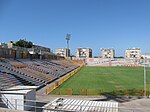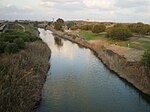Eshkol Power Station

The Eshkol Power Station is a power station supplying electrical power to the Shephelah region in Israel. It is located in north industrial zone of Ashdod near the mouth of the Lakhish River, close to the port of Ashdod and the Ashdod Oil Refineries which provided the plant with fuel oil prior to its conversion to use natural gas. The power station is also close to the sea since its cooling system uses sea water. Like other significant power stations in Israel, Eshkol Power Station belongs to Israel Electric Corporation. It is the third biggest power plant in Israel in terms of production ability, providing 7.3 percent of electricity production by IEC. The power station was named after Levi Eshkol, former Prime Minister of Israel.
Excerpt from the Wikipedia article Eshkol Power Station (License: CC BY-SA 3.0, Authors, Images).Eshkol Power Station
Ashdod
Geographical coordinates (GPS) Address Nearby Places Show on map
Geographical coordinates (GPS)
| Latitude | Longitude |
|---|---|
| N 31.847486111111 ° | E 34.66195 ° |
Address
9275000 Ashdod
South District, Israel
Open on Google Maps








